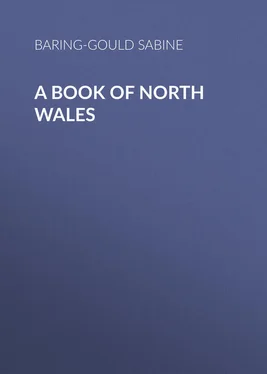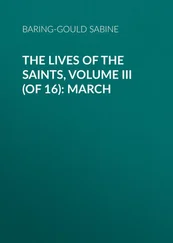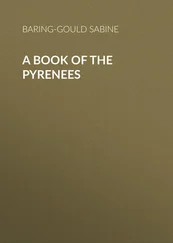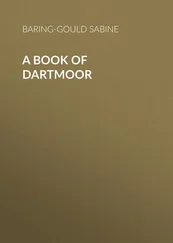Sabine Baring-Gould - A Book of North Wales
Здесь есть возможность читать онлайн «Sabine Baring-Gould - A Book of North Wales» — ознакомительный отрывок электронной книги совершенно бесплатно, а после прочтения отрывка купить полную версию. В некоторых случаях можно слушать аудио, скачать через торрент в формате fb2 и присутствует краткое содержание. Жанр: foreign_antique, foreign_prose, на английском языке. Описание произведения, (предисловие) а так же отзывы посетителей доступны на портале библиотеки ЛибКат.
- Название:A Book of North Wales
- Автор:
- Жанр:
- Год:неизвестен
- ISBN:нет данных
- Рейтинг книги:4 / 5. Голосов: 1
-
Избранное:Добавить в избранное
- Отзывы:
-
Ваша оценка:
- 80
- 1
- 2
- 3
- 4
- 5
A Book of North Wales: краткое содержание, описание и аннотация
Предлагаем к чтению аннотацию, описание, краткое содержание или предисловие (зависит от того, что написал сам автор книги «A Book of North Wales»). Если вы не нашли необходимую информацию о книге — напишите в комментариях, мы постараемся отыскать её.
A Book of North Wales — читать онлайн ознакомительный отрывок
Ниже представлен текст книги, разбитый по страницам. Система сохранения места последней прочитанной страницы, позволяет с удобством читать онлайн бесплатно книгу «A Book of North Wales», без необходимости каждый раз заново искать на чём Вы остановились. Поставьте закладку, и сможете в любой момент перейти на страницу, на которой закончили чтение.
Интервал:
Закладка:
Unhappily a marble quarry is close by, and is eating into one of the arms that is wrapped lovingly about the old site, and will in time eat its way through.
In the combe, among ancient walnut and chestnut trees and flowering elder, are some relics of the monastery and its Norman priory church. The foundation of the cloister may be traced. The church is cruciform, and is aisleless. The south transept contains rich Norman arcades, and the arch into this transept is of the same period and of equal richness. A square font in the nave, covered with interlaced and key work, is the base of an old Celtic cross. A Norman doorway on the south side gives admission to the nave. This has knotwork and a monster biting its tail in the tympanum. The chancel is three steps below the level of the nave. A fine cross is in the south transept, taken out of the ruins of the priory, where it had served as lintel to a mediæval window.
S. Seiriol, the founder, is represented in stained glass of the fifteenth century in a window of the south transept, and a bishop, probably S. Elian, in one of the north transept. Near the church is the holy well of the saint, gushing forth from under a rock, and filling what was once the priory fishpond. The well is now in request mainly by such as desire to know what is in store for them in their love affairs, by dropping in pins and forming wishes.
About a mile distant, on a height where the rock comes to the surface, are four holes – the sockets for a pair of gallows, as the Prior of Penmon had seigneurial rights, and could hang misdoers.
Just off the coast is Ynys Seiriol, or Puffin Island, with the tower and ruins of a church on it. Hither retreated the monks of the first Celtic monastery to die and to be buried, and the soil is dense with their bones. The rabbits turn them up when burrowing. Here, according to tradition, Maelgwn, king of Gwynedd, was buried in 547. He was son of Caswallon, who drove the Irish out of Anglesey. Maelgwn was a remarkable man, tall and noble of countenance, and a masterful prince. He incurred the wrath of the ecclesiastics because he had once been a monk and had thrown aside the cowl. He was not particularly scrupulous about the rights of sanctuary claimed by the saints, and he was imperious in requisitioning meals of them when hunting in their neighbourhood.
He was, however, large-hearted and liberal, and when Caw, a prince of Strathclyde, and his sons came helter-skelter into Gwynedd, flying from the Picts, he generously received them and gave them lands in Anglesey.
Somewhat later, Gildas the historian, one of the sons of Caw, when himself safe in Brittany, wrote his venomous letter on the Destruction of Britain , and thus indecently and ungratefully attacked Maelgwn, the protector of his family: —
“Thou island dragon, first in wickedness, exceeding others in power and in malice, liberal in giving , but more prompt in sin, strong in arms, but stronger in what destroys the soul, why dost thou wallow in such a black pool of crimes? Why dost thou lade thy neck with such loads of heavy crimes? Thy conversion once on a time brought as much joy as now thy accursed reversion to thy disgusting vomit, like a sick dog, has caused sorrow. Thy ears are not given to listen to sacred hymns, but to the bawling of a rascally crew howling out lies and frothing phlegm, bespattering everyone round about.”
Probably Maelgwn was not a good man, but the family of Gildas owed every yard of land it possessed to his munificence. By a word only does Gildas allude to their indebtedness to him; not an indication appears of loving pity – all is scurrilous abuse of the most insulting description. He was a sixth-century counterpart of Mr. Cutcliffe Hyne’s Captain Owen Kettle, a curious combination of narrow religiousness and foulmouthedness. No wonder that in Brittany his symbol is a snarling cur. And the meanness of the man is conspicuous throughout. So long as his own skin was safe from the lash it deserved, he gave no thought to his kinsmen living under the protection of Maelgwn and other princes against whom he inveighed – with what unpleasant consequences to them we shall see presently.
At Ruys, in the Morbihan, is a very beautiful marble statue of him, set up by his tomb a few years ago. It represents a young monk with angelic face, and a mouth in which butter would not melt. It is too funny for words to look at that idealised portrait and read the Destruction of Britain .
And now the bones of Maelgwn lie in Ynys Seiriol. In 1897 some excavations were made on the island by Mr. Harold Hughes, who says: —
“On removing the debris of centuries” – near the ruined church – “with the aid of pick and shovel we have succeeded in making a considerable clearing immediately to the east of the structure. We discovered at about four feet from the surface an ancient tomb. Beneath the rough clay, worn slabs, and covered with shingle from the shore, lay within a narrow inclosure, with feet to the east, the skeleton of a man. Although portions of the skeleton had crumbled away, many fragments remained, and these, after much difficulty, I pieced together.”
Was this, one may ask, the tomb of the famous Maelgwn Gwynedd?
From the island a reef runs into the sea, called the Causeway of Seiriol, and it is supposed that it was constructed by the saint as a means of communication with Penmaen Mawr. It disappears under the Dutchman’s Bank, a sandy stretch that obstructs the entrance to the Menai Straits. Hereon, in 1831, the Rothesay Castle was cast, when a hundred lives were lost. Miss Martineau, in her History of the Thirty Years’ Peace , tells a striking story of this wreck: —
“Two men, strangers to each other, found themselves holding on to the same plank, which, it soon appeared, would support only one. Each desired the other to hold on, the one because his companion was old, the other because his companion was young, and they quitted their grasp at the same moment. By extraordinary accidents both were saved, each without the knowledge of the other, and they met on the shore in great surprise. Few greetings in the course of human life can be so sweet and moving as must have been that of these two heroes.”
The country for some distance west of Penmon is commanded by Tin Sylwy or Bwrdd Arthur as it is also called. It rises 500 feet above the sea and is crowned by a fortification. The wall is of stone unset in mortar, faced within and without with slabs set on end, and within the area are faint traces of cytiau or circular huts of stone, such as are traditionally attributed to the Irish. Some excavations have been made here, but not on an extensive scale, and Roman coins and Samian ware have been found; but the extant walling assuredly belongs to the Gwyddyl invasion and occupation. Below the camp, between it and the church of Llanfihangel, is a holy well. In the graveyard may be noticed a token of a change of feeling towards the Welsh tongue. To the date 1860, or thereabouts, the inscriptions on the tombstones are in English, after that date in Welsh.
There is nothing in the church of Llaniestyn but the very curious carved slab with a full-length figure of the saint who founded the church. One very similar and of the same period, the reign of Edward III., is in Llanbabo Church. Iestyn was a son of Geraint, the heroic king of Devon and Cornwall, who fell at Langport, in Somersetshire, fighting against invaders, about the year 522. Iestyn was buried here. He seems to have travelled, and it is probably of him that a pretty story is told.
He had gone to Brittany, and had found a deserted habitation at Plestin, of which he took possession. The hut had been constructed by an Irish settler named Efflam, who had departed on a pilgrimage. On his return Efflam found his cell in the occupation of a stranger. The question arose as to which should have it. This they decided to determine in the following manner. Both seated themselves in the cabin. The day was overcast, but the clouds were breaking, and the sun was nearing its setting. He on whom it first shone should retain the hovel. Presently the clouds parted, and a golden ray shot in through the little window and blazed on Efflam’s upturned face. Then Iestyn rose, bowed, and withdrew, and ended his days in Mona. It is by an artist’s licence that on the monument Iestyn is represented wearing a crown. He was, indeed, a king’s son, but he never bore the royal circlet.
Читать дальшеИнтервал:
Закладка:
Похожие книги на «A Book of North Wales»
Представляем Вашему вниманию похожие книги на «A Book of North Wales» списком для выбора. Мы отобрали схожую по названию и смыслу литературу в надежде предоставить читателям больше вариантов отыскать новые, интересные, ещё непрочитанные произведения.
Обсуждение, отзывы о книге «A Book of North Wales» и просто собственные мнения читателей. Оставьте ваши комментарии, напишите, что Вы думаете о произведении, его смысле или главных героях. Укажите что конкретно понравилось, а что нет, и почему Вы так считаете.












